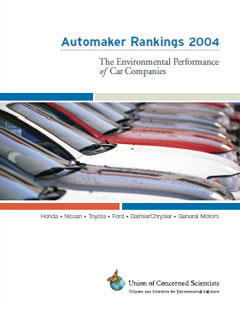The pollution performance of just a handful of corporations has a dramatic impact on the air we breathe and the climate we will pass on to future generations. The six largest automakers in the U.S. market—General Motors (GM), Ford, DaimlerChrysler, Toyota, Honda, and Nissan—are responsible for more than 90 percent of the heat-trapping and smog-forming emissions from new automobiles today. This lackluster environmental performance gives the industry a negative image and increases concern among investors that automakers are poorly positioned in a global market where environmental stewardship is becoming a competitive priority.
Automaker Rankings 2004: The Environmental Performance of Car Companies uses government data to provide a quantitative analysis of automakers' environmental performance. By presenting a clear, objective ranking of the Big Six automakers, this report can help consumers, investors, and lawmakers sort through manufacturers' billion-dollar advertising campaigns and public relations efforts to find out which one is truly the greenest when the rubber meets the road. We analyze the average emissions of the fleet of cars, SUVs, minivans, and pickups sold by these six car companies to rank their performance based on an equal weighting of their relative contribution to smog and global warming.
Ranking results
Clear differences exist among the automakers when it comes to environmental performance. Since our first automaker ranking report, for model year 1998 (MY98), a trend has emerged for the market leaders and laggards: Honda has consistently remained at the top, representing the cleanest of the Big Six automakers, while GM has consistently fallen in our rankings, from fourth place in our first ranking to last place in 2003, the latest model year for which data were publicly available. The difference between Honda and GM is most apparent in smog-forming pollution; Honda's vehicles produce less than half the pollution of the fleet average, while GM's produce nearly a third more than the average.
The pollution performance for other automakers has been less consistent, with Nissan taking over second place from Toyota due to reduced contributions to smog and global warming, Ford holding its position after making gains in MY01, and DaimlerChrysler moving out of last place for the first time in our rankings. Overall, the smog-forming pollution performance of the industry continues to improve in response to new regulations, while global warming pollution performance remains stuck in neutral.




